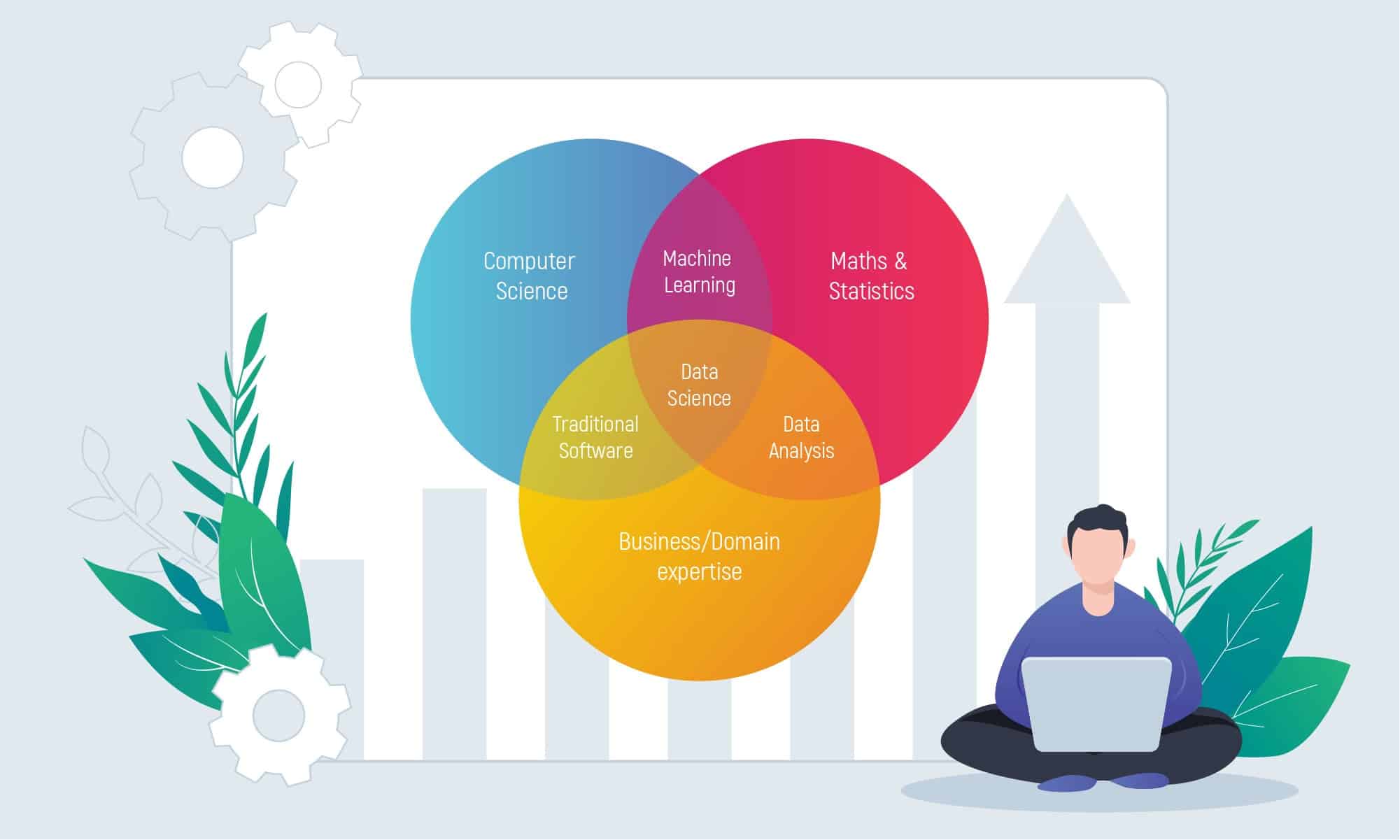Thriving as a successful company today means being data-driven. Over the years, we have witnessed how businesses adopt the latest technologies to increase the return on investment and boost productivity. Among these are Data Analytics, Big Data, AI, ML, and Data Science. For instance, what do tech- giants like Amazon, Netflix, and Uber have in common? They are data-first enterprises that adopt data-driven models to make better decisions based on data analytical insights.
Today we are dealing with Data Science almost every day: from searching movies on a streaming platform to getting recommendations for whatever you are looking for on the Internet.
To ensure your company is ready to lead the market, explore our list of recent trends in Data Science that will dominate the software development landscape in the near future.
- What is Data Science?
- Why is data science important?
- The Importance of Data Analytics
- Product development
- Efficient Operations
- Consumer-Centric Content
- Data Science Trends – Use Cases – Beyond 2023
- Big Data on the Cloud
- Augmented Analytics
- Robotic Process Automation
- Data-driven Customer Experience
- AI-As-a-Service Platforms
- Small Data and Scalable AI
- Blockchain
- The adoption of Python
- Consider Inoxoft Your Trusted Partner
- Final Thoughts
What is Data Science?
“Data science is the discipline of making data useful.”
Data science aims to build, clean, and organize datasets. By creating, and leveraging algorithms, statistical models, and custom analyses, data scientists turn structured and unstructured data into meaningful insights and apply it across a range of application domains.
According to Harvard Business Review, Fortune 1000 companies are investing in data and AI initiatives.
- 91,9% of companies report that the pace of investment is accelerating
- 62% report investments of more than $50 million.
So, finally, what are trends in data science? Let’s move forward to discover.
Why is data science important?
Data science is becoming a vital field with significant industry implications in the information and technology age. It is crucial that data science be used to drive innovation, make educated decisions, and extract useful information. These are the main justifications for why data science is so important today:
- Informed Decision-Making: Data science empowers organizations to make decisions based on evidence and insights rather than intuition alone. Businesses can identify patterns, trends and correlations through the analysis of large data sets that will facilitate a more informed and strategic decision-making process.
- Business Intelligence and Strategy: Robust business intelligence is based on data science. Organizations may use data to better understand consumer behavior, market trends, and competitive situations. This understanding will therefore aid in creating winning business plans and maintaining an advantage in quickly changing markets.
- Predictive analysis: One of the key advantages of data science is its capacity to predict patterns and results. With the use of predictive analytical models, businesses can forecast consumer preferences, market shifts, and potential hazards. Its vision makes strategic planning and preventative actions possible. Data science is a crucial component in the development of personalised goods, services, or user experiences.
- Personalization and customer experience: Businesses can tailor their products and services to the preferences of their clients by analyzing customer data, which boosts client happiness and loyalty. Customization turns into a competitive advantage in today’s market./p>
- Effective resource allocation and operation: Data-driven insights help organizations allocate resources and optimize their operations more efficiently. Enhancing general operations efficiency will result in lower costs and higher productivity. Other aspects of this will include streamlining the supply chain process and guaranteeing efficient inventory management.
- Innovation and product development: Data science serves as a catalyst for innovation and product development by exposing previously untapped markets and areas for improvement. By identifying market gaps, evaluating user needs, and forecasting emerging trends, it will support the creation of novel goods and services.
- Healthcare Advancements: Data science plays a critical role in patient care, treatment optimization, and medical research in the healthcare industry. Large dataset analysis will ultimately result in breakthroughs in drug development, personalized medicine, and disease detection, ultimately saving lives and improving medical outcomes.
- Fraud Detection and Security: Data science is used by financial institutions and businesses to detect and secure fraud. Organizations that analyze patterns and anomalies in transaction data can identify possible fraudulent activity and improve the security of their financial systems.
- Scientific Research and Exploration: Data science speeds up discoveries and exploration in scientific research. Data science is essential to the advancement of knowledge because it can be used to simulate complex phenomena and analyze genomics data.
- Constant learning and adaptation: A culture of constant learning and adaptation is fostered by data science. By routinely evaluating data and keeping an eye on performance metrics, organizations can adjust to shifting conditions, market dynamics, and customer preferences, helping them to cope with a world that is changing quickly.
In essence, data science is the information age’s engine, giving businesses the tools they need to innovate, acquire insightful knowledge, and solve challenging issues. It is a significant issue that affects the entire industry, affecting not only how we handle obstacles and make decisions but also how we will be shaped in the future. The importance of data science to the success and advancement of humanity as a whole will only grow with the amount of information we gather.
The Importance of Data Analytics
Data analysis, which gives businesses a powerful toolkit, is increasingly becoming essential in today’s business environment to help them gain transformative insight, enhance their decision-making procedures, and achieve overall success. Data analysis has a significant impact on strategy formulation, customer interaction, and operational effectiveness across multiple industries.
Product development
The process of developing new or improved products that meet the needs and expectations of customers, stakeholders and market participants is called product development. Data Analytics is used to generate insight, decision making and optimization of outcomes. Analytics of data are important for product development, because it helps to:
- Determine clients’ needs and issues. Product managers can use data analysis to understand customer preferences and pain points in addition to understanding what products customers are looking for. This can help in the development of goods that solve actual issues and add value for consumers.
- Check the product’s assumptions and concept. Product managers can test their assumptions and hypotheses about their products, including the value proposition, target market, features, and price, by using data analysis. This strategy can reduce risk, prevent expensive mistakes, and boost confidence in product choices.
- Measuring the products’ impact and performance is necessary. Product managers can track and assess a product’s performance in terms of usage, engagement, retention, revenue, and customer satisfaction by using data analysis. This makes it possible to evaluate how products affect company goals, customer outcomes, and opportunities for innovation or improvement.
- Boost the features and design of the product. Product managers can create products that are appealing, intuitive, and easy to use with the aid of data analytics. Product managers can determine the most crucial and desired features and optimize them for usability and satisfaction by examining user behavior, feedback, and preferences. A/B testing, multivariate testing, and other experiments can be carried out with the aid of data analytics in order to compare various design options and determine which is optimal.
- Segment and target the customer. Product managers may find it helpful to segment and target their customer base using data analysis based on various parameters like needs, behavior, psychographic traits, and demographics. This has the potential to enhance the development of tailored and pertinent products, advertising campaigns, and customer experiences. Data analysis can also help identify potential customers, niche markets, and new market opportunities.
- Innovate and iterate products. Data Analytics can help product managers to innovate and develop their products based on changing customer needs, market trends as well as a competitive landscape. Product managers are able to identify new challenges, opportunities and ideas for product improvement or innovation by monitoring and analysing data from a variety of sources such as customer feedback, social media, industry reports and competitor analyses. Data analytics can also help to measure the impact of product changes and enhancements, and to learn from failures and successes.
Efficient Operations
Efficient operations are the ability to perform business processes and tasks with optimal speed, quality, and cost. Data Analytics is the use of data for insight, decision making and optimization. Data analytics can help to improve the efficiency of operations by:
- Optimisation of the process: Data Analytics may help to simplify and enhance existing work processes, cut down on waste or increase productivity. Businesses can detect bottlenecks, inefficiencies and areas for improvement through analysing data from various sources such as sensors, Internet of Things devices or customer surveys. In order to compare different process options and select the best one, data analysis may also be useful in carrying out experiments such as A/B testing.
- Resource allocation: Data Analytics can help to use available resources, e.g. labour, materials and time, which are best suited for meeting demands while saving costs. Enterprises can optimise their resource use, allocation and scheduling by analysing data from past records, today’s operations as well as the longer term outlook. The monitoring and control of resource consumption and performance may also be assisted by data analysis.
- Data-driven decision making: Data analytics can help make more informed and evidence-based decisions that lead to better operational outcomes. Businesses can gain valuable information on their strengths, weaknesses, opportunities and threats through the collection and analysis of data from a variety of sources, e.g. market trends, customer behaviour or competitors’ analyses. Analytics can also help to test hypotheses, validate assumptions, and evaluate alternatives.
- Customer insights: Data Analytics can help us understand and anticipate customer needs, preferences or expectations. Businesses will be able to identify and reach their customers based on a number of criteria, e.g. demographic characteristics, psychographics or behaviour analysis, by analyzing data from customer interactions, feedback and transactions. In order to increase customer loyalty and retention, data analysis can also help in the creation of personalised products, services or experiences which are appropriate.
- Optimisation of the supply chain: Data Analytics may help to optimise a whole supply chain, e.g. from source to distribution. Businesses can reduce their inventories, improve delivery times and lower transport costs by analysing information from suppliers, inventory, logistics and demand. Risk to the supply chain, e.g. disruptions, shortages or quality issues, can also be predicted and mitigated through data analysis.
This is one of the ways in which data analysis can contribute to improved operational effectiveness. For businesses who want to optimize their performance, decrease costs and increase customer satisfaction, data analysis can give them an edge in competition.
Consumer-Centric Content
The creation and delivery of content that is relevant, personalised, and engaging for the target audience is consumer-centric content. Analytics is the use of data to generate insights, make decisions, and optimize results. Data analytics can assist in the creation of content for consumers by:
- Understand the customer’s preferences and behaviour. In order to gain a better understanding of customers’ needs, interests and interactions with content, data analysis can be used to collect and analyse data from different sources like surveys, focus groups, interviews, social media and web analytics. The creation of content that meets their needs, wants, and expectations can be helpful.
- The segmentation and targeting of customers. Based on a variety of criteria, like demographics, psychographics, behaviour and needs, data analysis can help segment and target customers. This can also help to develop content that is tailored and appropriate for each customer segment, as well as make it available on the best possible channels and platforms.
- Testing and optimising the content. By measuring the performance and impact of the content on various metrics, such as views, clicks, conversions and satisfaction, data analysis can help to test and optimize the content. It can help to assess the effectiveness of content and identify areas where improvement or innovation could be made. Data analytics can also help conduct experiments, such as A/B testing, multivariate testing, and content personalization, to compare different content options and select the best one.
- Education and improvement of content. By gathering and analysing customer feedback, such as ratings, reviews, comments or suggestions, data analysis can help with content discovery and improvement. It can also help to understand the strengths and weaknesses of content, so as to incorporate feedback from customers when developing or improving content. In order to keep up with the market, data analysis may also be useful for monitoring and tracking content trends, best practices or competitors’ strategies.
This is one of the ways in which data analysis can help to create consumer-centric content. For businesses who want to attract, engage and retain their customers with content which is of value, meaning or pleasure, data analysis may offer competition advantages.
Data Science Trends – Use Cases – Beyond 2023
Big Data on the Cloud
This trend appeared as a solution to the problem of collecting, cleaning, structuring, formatting, and analyzing a tremendous amount of data in one place. Up to 45% of businesses turned towards cloud-based data storage, processing, and distribution. One of the emerging trends in data science is the use of private and public cloud services for big data predictive analytics. This year, 90% of data and analytics innovation will demand public cloud services.
Today, any sort of information can be maintained in cloud storage and the amount of this information is growing. In two years, there will be 163 zettabytes of data (with one zettabyte equals 1 billion terabytes or 1 trillion gigabytes)
Augmented Analytics
According to Gartner, augmented analytics is an approach of enabling ML, AI, and NLP to automate the data analysis (data preparation, insight generation insight explanation) in real-time.
Augmented analytics helps businesses get value from their data without technical skills or expertise and in less time than usual which puts the technology on the Data Science trends list. Other benefits:
- Increased speed to insight
- The result is more accurate
- Automated operational tasks
- Powerful analysis in the context
Augmented Analytics Features
- Automatic data identification
- Statistical algorithms ( forecasting, clustering, etc)
- Natural language interactions
Examples of Augmented Analytics use cases
- In supply chain management it helps to understand why a particular location isn’t delivering products as scheduled.
- Travel agencies find personalized offers to sell customers.
- Marketing agencies explore the effectiveness of ad campaigns and find variables that are hidden in the data.
Robotic Process Automation
The rise of digital solutions, mobile payments, and cryptocurrency forced financial institutions to implement new technologies to maintain a competitive advantage and provide better services to their customers. So, among other data science trending topics is RPA, or robotic process automation which is used by financial institutions to automate manual business processes.
RPA use cases include risk assessments, credit card processing, security checks, data analysis and reporting, compliance processes, mortgage processing, report automation, fraud detection as well as other administrative activities. This gives financial institutions more time and workforce to perform their core responsibilities.
Top benefits of RPA:
- Saved time and money
- Automated processes
- Augment workers with a digital workforce
- Controlled compliance costs
- Improved Customer Experience
Discover more on data science and finance!
Data-driven Customer Experience
The future of data science includes providing valuable, and enjoyable experiences, to clients, by businesses. Finding new strategies for leveraging client data into better customer service and new customer experiences led to a wave of innovation and greater levels of personalization in goods and services in the eCommerce industry.
In this case, data-driven customer experience means personalized product recommendations, demand forecasting, Personalized experience, help from AI chatbots, more user-friendly interfaces in the software we use, etc.
AI-As-a-Service Platforms
With data science evolving, AI-as-Service platforms and services are becoming one of the data science industry trends. According to International Data Corporation worldwide spending on AI is expected to reach $110 billion in 2024 compared to $50 billion in 2020.
AIaaS refers to AI tools that enable companies to implement and scale AI techniques at half of the cost of a full, in-house AI. Common types of AIaaS include chatbots & digital assistance, cognitive computing APIs, Machine Learning frameworks. Among well-known companies that have brought AIaaS are Amazon Web Services (AWS), Google Cloud Platform (GCP), and Microsoft Azure. And also, Salesforce, Oracle, and SAP.
Using AIaaS allows to:
- Minimize the risk of investment
- Stay focused on core business
- Gain more value from your data
- Improve strategic flexibility
- Make cost transparent
Platforms like Shopify, Lightspeed Square enable businesses optimized with AI to evolve faster.
Small Data and Scalable AI
As data usage and data types have become more complex and diverse in recent years, among the latest data science market trends is a move away from big data. Gartner forecasts that by 2025, 70% of organizations will turn their focus to small and wide data. Despite the fact small data is limited in volume, it offers even more effective insights. Scalable AI means the ability of data models, algorithms, and infrastructure to perform at the size, speed, and complexity required for a particular task.
Blockchain
Blockchain has already become a familiar term in fintech, healthcare, and the supply chain and now it made it to the data science latest trends list. From a data science perspective, it is also a source of high-quality data that can be employed to resolve a range of problems using statistics and Machine Learning.
Both data science and blockchain deal with data and both use algorithms created to manage interactions with different data segments. But with blockchain, there is no need for a central perspective where all data should be brought together as it used to be. Now it’s a decentralized approach where data can be analyzed outside of individual devices. Also, blockchain smoothly integrates with advanced technologies, like cloud systems, AI, and IoT.
Use cases in blockchain analysis:
- Blockchain analysis for competitive intelligence
- for confidentiality and security
- in research
- for forensic investigations
The adoption of Python
R used to be a primary programming language of data. And now the focus is on Python. It requires fewer lines of code to achieve the same results, is suitable for a range of business types, and is more accessible to those who have less experience. The diversity of this coding language allows you to write all your data analysis in the same language( from blockchain applications to machine learning models) In the application development market deep learning algorithms becoming popular, so professionals have driven the adoption of Python programming language within an industry.
Consider Inoxoft Your Trusted Partner
Inoxoft is a company providing top-notch data science development services and machine learning development services that include:
Our main focus here is to follow the trends and impact the market with big data-driven software development.
Learn more about big data analytics in finance and check the examples of predictive analytics in retail
Final Thoughts
Our daily life is driven by Data Science as every Google search triggers different Data Science processes. We all are captured with smart solutions and recommendations of what to buy based on products we bought in the past. From AI-As-a-Service Platforms and Augmented Analytics to other latest technologies in data science, the industry is transforming every year, continuing to influence the market.
You can get powerful tools to build a product that will change the way of doing business and transform industries. Do you want to lead? Ask us how!
Frequently Asked Questions
What are data science trends in 2022?
- The adoption of Python
- Blockchain
- Augmented Analytics
- Big Data on the Cloud
- Small Data and Scalable AI
- Robotic process automation
What is the role of Data Science in web development?
- Reduce human error
- Enchace personalization
- Obtain a perfect digital assistant
- Predict the impact
- Adopt innovations right now
- Increase productivity











